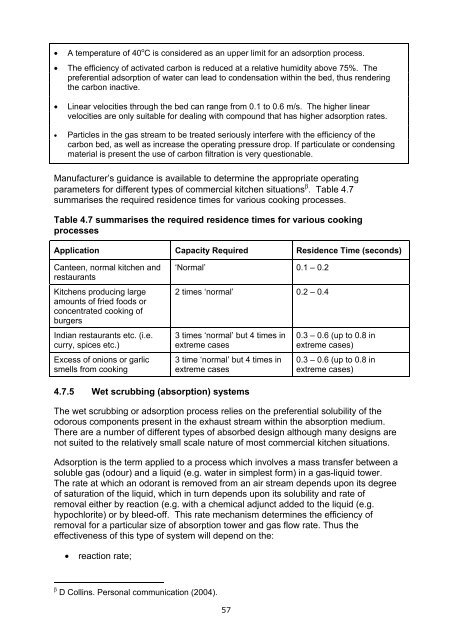Guidance on the Control of Odour and Noise from ... - Defra
Guidance on the Control of Odour and Noise from ... - Defra
Guidance on the Control of Odour and Noise from ... - Defra
You also want an ePaper? Increase the reach of your titles
YUMPU automatically turns print PDFs into web optimized ePapers that Google loves.
• A temperature <strong>of</strong> 40 o C is c<strong>on</strong>sidered as an upper limit for an adsorpti<strong>on</strong> process.<br />
• The efficiency <strong>of</strong> activated carb<strong>on</strong> is reduced at a relative humidity above 75%. The<br />
preferential adsorpti<strong>on</strong> <strong>of</strong> water can lead to c<strong>on</strong>densati<strong>on</strong> within <strong>the</strong> bed, thus rendering<br />
<strong>the</strong> carb<strong>on</strong> inactive.<br />
• Linear velocities through <strong>the</strong> bed can range <strong>from</strong> 0.1 to 0.6 m/s. The higher linear<br />
velocities are <strong>on</strong>ly suitable for dealing with compound that has higher adsorpti<strong>on</strong> rates.<br />
• Particles in <strong>the</strong> gas stream to be treated seriously interfere with <strong>the</strong> efficiency <strong>of</strong> <strong>the</strong><br />
carb<strong>on</strong> bed, as well as increase <strong>the</strong> operating pressure drop. If particulate or c<strong>on</strong>densing<br />
material is present <strong>the</strong> use <strong>of</strong> carb<strong>on</strong> filtrati<strong>on</strong> is very questi<strong>on</strong>able.<br />
Manufacturer’s guidance is available to determine <strong>the</strong> appropriate operating<br />
parameters for different types <strong>of</strong> commercial kitchen situati<strong>on</strong>s β . Table 4.7<br />
summarises <strong>the</strong> required residence times for various cooking processes.<br />
Table 4.7 summarises <strong>the</strong> required residence times for various cooking<br />
processes<br />
Applicati<strong>on</strong> Capacity Required Residence Time (sec<strong>on</strong>ds)<br />
Canteen, normal kitchen <strong>and</strong><br />
restaurants<br />
Kitchens producing large<br />
amounts <strong>of</strong> fried foods or<br />
c<strong>on</strong>centrated cooking <strong>of</strong><br />
burgers<br />
Indian restaurants etc. (i.e.<br />
curry, spices etc.)<br />
Excess <strong>of</strong> <strong>on</strong>i<strong>on</strong>s or garlic<br />
smells <strong>from</strong> cooking<br />
‘Normal’ 0.1 – 0.2<br />
2 times ‘normal’ 0.2 – 0.4<br />
3 times ‘normal’ but 4 times in<br />
extreme cases<br />
3 time ‘normal’ but 4 times in<br />
extreme cases<br />
4.7.5 Wet scrubbing (absorpti<strong>on</strong>) systems<br />
57<br />
0.3 – 0.6 (up to 0.8 in<br />
extreme cases)<br />
0.3 – 0.6 (up to 0.8 in<br />
extreme cases)<br />
The wet scrubbing or adsorpti<strong>on</strong> process relies <strong>on</strong> <strong>the</strong> preferential solubility <strong>of</strong> <strong>the</strong><br />
odorous comp<strong>on</strong>ents present in <strong>the</strong> exhaust stream within <strong>the</strong> absorpti<strong>on</strong> medium.<br />
There are a number <strong>of</strong> different types <strong>of</strong> absorbed design although many designs are<br />
not suited to <strong>the</strong> relatively small scale nature <strong>of</strong> most commercial kitchen situati<strong>on</strong>s.<br />
Adsorpti<strong>on</strong> is <strong>the</strong> term applied to a process which involves a mass transfer between a<br />
soluble gas (odour) <strong>and</strong> a liquid (e.g. water in simplest form) in a gas-liquid tower.<br />
The rate at which an odorant is removed <strong>from</strong> an air stream depends up<strong>on</strong> its degree<br />
<strong>of</strong> saturati<strong>on</strong> <strong>of</strong> <strong>the</strong> liquid, which in turn depends up<strong>on</strong> its solubility <strong>and</strong> rate <strong>of</strong><br />
removal ei<strong>the</strong>r by reacti<strong>on</strong> (e.g. with a chemical adjunct added to <strong>the</strong> liquid (e.g.<br />
hypochlorite) or by bleed-<strong>of</strong>f. This rate mechanism determines <strong>the</strong> efficiency <strong>of</strong><br />
removal for a particular size <strong>of</strong> absorpti<strong>on</strong> tower <strong>and</strong> gas flow rate. Thus <strong>the</strong><br />
effectiveness <strong>of</strong> this type <strong>of</strong> system will depend <strong>on</strong> <strong>the</strong>:<br />
• reacti<strong>on</strong> rate;<br />
β D Collins. Pers<strong>on</strong>al communicati<strong>on</strong> (2004).
















